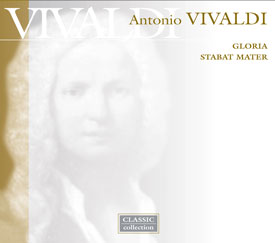Unless you know the difference between Gloria RV588 and
Gloria RV589, you will not realise that this disc contains a performance
of Vivaldi’s lesser known Gloria in D major. Written at about the
same time (between 1713 and 1719) it shares thematic material with
its better known companion. Here, Gloria RV588 is correctly preceded
by the Introduction (Introduzione in D major, Jubilate o amaeni,
RV639) in its version for Alto solo. The companion piece to the
Gloria is the ravishing Stabat Mater. All well and good, the stage
seems to be set for an enjoyable recital.
The Netherlands Bach Collegium is a fine period
instrument ensemble and throughout this disc they give a lithe
performance with well sprung rhythms. Unfortunately, this stylish
impression is dispelled when counter-tenor Sytse Buwalda starts
the vocal part in the Introduction. He has problems with both
passage-work and tuning which creates a fatal opening impression
which is not entirely dispelled by the remainder of the Gloria.
The choir make a fine, clear sound and in the concerted passages
deliver a shapely performance. In a number of passages marked
Coro in the notes, Leusink seems to use an ensemble of the soloists
which is less successful in terms of the balance and blend of
the voices. There were also a number of moments when the choral
altos seemed to develop a distinctive edge their tone, which I
did not like. I am afraid that, for me, this rather soured what
would otherwise have been a fine performance. The chorus ‘Et in
terra pax’ is harmonically fascinating but the profoundly untidy
descending scales in the choir rather ruin the effect. The Soprano
and Alto duet, ‘Laudamus te’ is a wonderful dance, performed with
admirable bounce by the orchestra. In this movement, the Alto
part sounds remarkably like a 2nd Soprano part. Tenor,
Martinus Leusink, gets one aria which he sings in an undernourished
tone and he could be more stylish. In addition to the duet, Soprano
Marjon Strijk gets two arias. She has an attractive light voice
and makes a stylish soloist in her arias. In her first one, ‘Domine
Deus’ she is complimented by a lovely oboe solo. Unfortunately
in his solos Buwalda reinforces the impression gained in the Introduction.
He sings his solo, ‘Qui sedes’, in a shapely manner but the aria
is marred by tuning problems. Whilst I was not always convinced
by some of the other choral movements, the choir give a strongly
powerful performance of the great final fugue.
The Netherlands Bach Collegium gives a ravishing
performance of the introduction to the Stabat Mater. Buwalda seems
to be in better voice here, both tuning and passage-work are quite
acceptable. This work seems to suit him better, or perhaps it
was just that more recording time was given to this piece. It
would make an admirable filler if only the performance of the
‘Gloria’ was better. But Buwalda’s style and vocal control hardly
compares to that of Andreas Scholl in his fine recording. And
it should be remembered that this work was probably written for
a female alto at the Pieta. So there is no reason to shy away
from recordings of this work by women and every reason for counter-tenors
to convince us (as Scholl most emphatically does).
Robert Hugill
